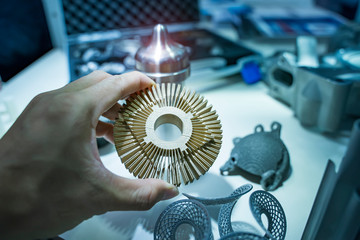Metal 3D printing technology allows you to create intricate metal objects layer by layer. With processes like Powder Bed Fusion and Selective Laser Melting, you can produce complex shapes with ease.
Metal 3D printing is used in various industries, from aerospace to automotive, thanks to its ability to create internal structures and multi-material parts.
But there are limitations too, like slower speed and higher costs.
In this discussion, we’ll cover everything you need to know about metal 3D printing.
Metal 3D Printing Technologies
If you want to explore metal 3D printing technologies, there are various options such as Powder Bed Fusion (PBF), Selective Laser Melting (SLM), Direct Energy Deposition (DED), Binder Jetting, and Sheet Lamination.
Metal 3D printing, also known as additive manufacturing, is a revolutionary process that allows for the creation of complex metallic parts layer by layer. It offers numerous benefits such as the ability to create internal structures, production of overhangs and cantilevers, printing of multi-material parts, and the creation of complex geometric shapes.
Powder Bed Fusion (PBF)
Powder Bed Fusion (PBF) involves spreading a thin layer of metal powder on a build platform and selectively fusing it using a laser or electron beam. This process offers high accuracy and resolution.
Selective Laser Melting (SLM)
Selective Laser Melting (SLM) uses a high-powered laser to melt the metal powder within a controlled atmosphere.
Direct Energy Deposition (DED)
Direct Energy Deposition (DED) involves depositing molten metal onto a substrate using an energy source such as lasers or electron beams.
Binder Jetting
Binder Jetting utilizes a liquid binder to join layers of powdered metal together.
Sheet Lamination
Lastly, Sheet Lamination involves bonding together sheets of metal using heat or adhesives.
Each technology has its own advantages and limitations depending on the specific requirements of your project.
Whether you’re looking for a metal 3D printer or considering using a metal 3D printing service, understanding these different technologies will help you make an informed decision based on your needs.
Metal 3D printing technology continues to evolve rapidly with continuous advancements being made in precision, speed, material selection, post-processing techniques, and cost-efficiency.
Overall, exploring the world of metal 3D printing opens up endless possibilities in industries such as aerospace, automotive, medical, industrial manufacturing, entertainment applications and more.
The ability to fabricate complex geometries with excellent mechanical properties makes it an attractive option for prototyping and producing end-use parts.
Benefits of Metal 3D Printing
One of the benefits of metal 3D printing is that you can create complex geometric shapes. This technology allows for the production of intricate and detailed designs that would be difficult to achieve using traditional manufacturing methods. Here are some advantages of metal 3D printing:
- Ability to print in a wide range of d printable metals, including titanium, steel, aluminum, and more.
- The process involves selectively melting metal powder layer by layer to build up the desired shape.
- Metal 3D printers use a high-power laser to fuse the metal particles together.
- The build platform moves down after each layer is printed, allowing for the creation of complex structures.
Metal 3D printing offers tremendous opportunities in various industries such as aerospace, automotive, medical, industrial, and entertainment applications.
It enables the production of end-use parts with complex internal structures and overhangs. Additionally, multi-material parts can be printed to meet specific requirements.
With continuous advancements in technology, metal 3D printing is becoming increasingly precise and efficient.
Geometries Suited for Metal 3D Printing
To create parts with specific properties such as strength and temperature resistance, consider geometries suited for metal 3D printing.
- Metal 3D printing offers the ability to produce complex internal structures, overhangs and cantilevers, multi-material parts, and complex geometric shapes. These geometries are achievable due to the layer-by-layer nature of the metal 3D printing process.
- With metal 3D printing, you can design intricate internal structures that would be impossible or difficult to create using traditional manufacturing methods. This enables you to optimize the performance of your parts by incorporating features such as lattice structures for light weighting or cooling channels for enhanced thermal management.
- Additionally, metal 3D printing allows for the production of overhangs and cantilevers without the need for support structures. This reduces material waste and post-processing efforts.
- Furthermore, the flexibility of metal 3D printing enables you to print multi-material parts with varying properties in a single build. This opens up possibilities for creating functional gradients within your components.
- Lastly, complex geometric shapes can be easily achieved through metal 3D printing. Whether it’s intricate curves or unique contours, this technology provides the freedom to bring your most innovative designs to life.
Limitations of Metal 3D Printing
The speed of metal 3D printing compared to traditional machining methods is one of its limitations. Metal 3D printing processes involve building objects layer by layer, which can be time-consuming. Here are some key factors that contribute to the speed limitation of metal 3D printing:
- Complex geometries: Metal 3D printers need to carefully deposit each layer of material, resulting in slower production times for intricate and complex designs.
- Cooling time: After each layer is deposited, it needs time to cool down before the next layer can be added. This cooling process adds to the overall printing time.
- High precision requirements: Metal 3D printing often requires high precision and accuracy, which means slower print speeds to ensure precise deposition of each layer.
- Post-processing steps: Once the object is printed, post-processing steps like support removal, surface finishing, and heat treatment may be necessary. These additional steps also add time to the overall production process.
Despite these speed limitations, metal 3D printing offers numerous benefits such as the ability to create complex geometric shapes and internal structures. It also provides a wide range of materials options for various industrial applications.
Continuous advancements in technology aim to address these limitations by increasing print speeds and improving overall efficiency in metal 3D printing processes.
Other Considerations for Metal 3D Printing
Metal 3D printing has made significant progress in addressing limitations through continuous advancements in technology. As you consider implementing metal 3D printing into your manufacturing processes, there are several other important considerations to keep in mind.
- Firstly, precision of the final product is a crucial factor. Metal 3D printing allows for high accuracy and intricate details, but it is essential to ensure that the specifications and tolerances meet your requirements.
- Post-processing requirements should also be taken into account. Depending on the specific metal 3D printing process used, post-processing steps such as cleaning, heat treatment, support removal, and surface coatings may be necessary to achieve the desired finish and properties.
- Safety concerns should not be overlooked when working with metal 3D printing. The use of lasers and potentially hazardous materials requires proper training and safety protocols to protect both operators and equipment.
- It is important to note that metal 3D printing is a rapidly evolving field with continuous advancements in technology. New developments are constantly being made to address existing limitations and improve the overall capabilities of metal 3D printers.
Applications of Metal 3D Printing
Applications of Metal 3D printing include manufacturing end-use parts, rapid prototyping, and customization in various industries such as aerospace, automotive, medical, industrial, and entertainment.
Aerospace
Metal 3D printing enables the production of complex geometries and lightweight structures in aerospace applications. It improves fuel efficiency and reduces aircraft weight by manufacturing end-use parts like turbine blades and engine components. Rapid prototyping and customization of aerospace parts are also possible with this technology.
Automotive
In the automotive industry, metal 3D printing is used for rapid prototyping and the production of lightweight and high-performance parts. Customization of automotive components is also achievable through this process. Engine parts, exhaust systems, and other components can be manufactured to improve fuel efficiency and reduce vehicle emissions.
Medical
Metal 3D printing plays a crucial role in medical applications by producing medical implants with patient-specific and complex geometries. This technology enhances the success rate of surgeries while reducing recovery time. Orthopedic implants, dental prosthetics, biocompatible devices with corrosion resistance are some examples.
Industrial
Metal 3D printing finds extensive use in various industrial sectors for manufacturing end-use parts. It allows for the production of complex and lightweight structures while enabling customization and rapid production of industrial components such as jigs, fixtures, molds that improve manufacturing efficiency while reducing costs.
These different industries benefit from metal 3D printing’s ability to manufacture end-use parts quickly while offering design flexibility for customized products.
Metals Used in 3D Printing
When exploring 3D printing with metals, you’ll discover a wide range of materials available for use in this innovative technology.
Titanium, steel, stainless steel, aluminum, copper, cobalt chrome, tungsten, and nickel-based alloys are some of the metals that can be used in metal 3D printing.
Additionally, precious metals like gold, platinum, palladium, and silver can also be used. Each metal offers different properties suitable for various applications. For example, stainless steel provides excellent corrosion resistance and is ideal for printing pipes and valves.
Metals like titanium and aluminum are commonly used in the medical, automotive, and aerospace industries due to their lightweight nature.
In metal 3D printing processes such as Direct Metal Laser Sintering (DMLS) and Selective Laser Melting (SLM), a laser is used to selectively fuse metal powder particles layer by layer to create the desired object.
Other techniques such as Binder Jetting and Metal Injection Molding combine different methods to achieve specific results.
It’s important to consider factors such as cost limitations due to high-quality powdered materials required for metal 3D printing and post-processing expenses. However, metal 3D printing offers advantages such as the ability to manufacture small complex parts efficiently and facilitate tooling for conventional manufacturing technologies.
It is suitable for a wide range of applications including fully functional prototyping and production tools in various industries such as aerospace, automotive, medical, industrial sectors or even entertainment purposes.



